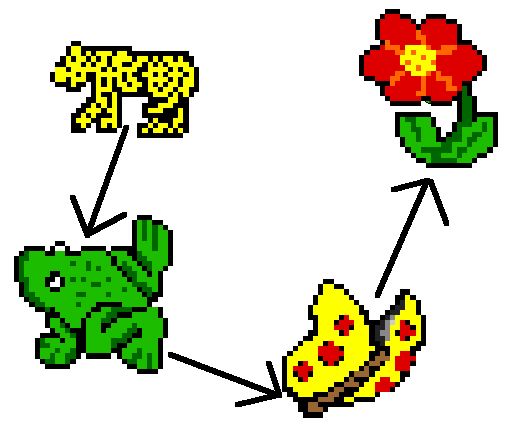LESSON 3
AIM: What is a rain forest food chain or web
of life?
MOTIVATION:
1. Show students pictures of
green plants. Who is this food for? Elicit a number of animals
that might eat these green plants.
2. Taking those animals, ask
students what other animals might eat those animals.
3. Keep on in this manner, until
you have reached humans.
4. Ask students to tell where
they get their energy from. They might suggest from the food they
eat. Take this information and follow it all the way back to the
green plants that get their energy from the sun.
PROCEDURE:
1. Introduce vocabulary associated
with food chains and put in a database for children to look up on line
at http://m-w.com or http://ran.org/ran/info_center/factsheets/k1.html
| herbivores |
Animals that eat only green plants |
| carnivores |
Animals that eat only other animals |
| omnivores |
Animals that eat both green plants and animals |
| producers |
Green plants that make food others to eat. |
| decomposers |
Tiny animals that break down dead matter and return the nutrients to
the soil. |
| consumers |
Any animal that uses plants or animals for food. They consume
the food. |
| interdependence |
The concept that everything in nature is connected to each other,
and cannot survive without the help of other plants, animals and abiotic
factors (such as sun, soil, water and air) around it. |
| adaptation |
A way of changing so that one species of plant or animal is suited
to another for purposes of food and reproduction. |
2. Have students create a rain forest
food chain. Doing research from
http://ran.org/ran/kids_action/index.html
children should choose a green plant found in the rain
forest, and see what animals have adapted to that plant and use it for
food. They should continue in this manner until they reach an animal
that is on the top of the food chain. Example:

3. Children working in cooperative
groups should research one plant and one animal that have adapted to each
other and show illustrations and examples of this. Students can take
turns being recorder, reporter, artist, leader, etc.
4. Review rain forest food chains
by asking questions like:
a. How
have we shown the interdependence of plants and animals in the rain forest?
b. What
would happen if one of the plants or animals in the rain forest would become
extinct? How would that affect other plants and animals in the food
chain?
ACTIVITIES:
1. Using KidPix, have students
create a food chain of their own based on their research of rain forest
plants and animals.
2. Children can also create
a food chain with construction paper and triangles and circles. The
triangle is for the producer (green plant), and the circles are for the
animals in the food chain (consumers, including herbivores, carnivores,
and omnivores). Let the students illustrate each plant and animal
in the food chain on the appropriate shape, and connect with string.
They could be displayed on a mobile in the room.
FOLLOW-UP: This lesson will lead into the
next lesson- "Why is the rain forest important?"
